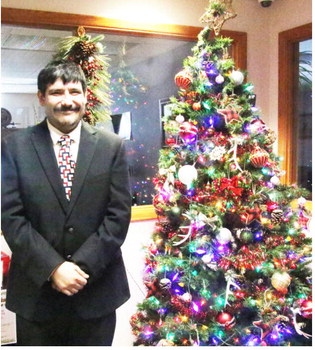Is It Time To Discuss State Sales Tax?
For generations, Montana voters have been famously averse to the notion of a statewide sales tax, repeatedly rebuffing efforts by political leaders to persuade them that one would be good medicine for the state’s public finances.
But ask Todd O’Hair, the leader of the state’s most prominent business association, and he’ll tell you a changing economy means it’s time for thoughtful Montanans to take a deep breath and ponder swallowing that pill.
O’Hair, the president and CEO of the Montana Chamber of Commerce, has made that case in a recent series of presentations around Montana. His logic goes something like this: Once upon a time, back in the ’60s and ’70s, Montana was a natural resource powerhouse with much of its economy driven by mining and timber production, big businesses that invested big bucks in industrial equipment and large buildings to house their operations. That big equipment and big real estate beefed up Montana’s tax rolls, the taxes on it covering much of the bill for schools, law enforcement and other property tax-funded local services.
Twenty-five years into the 21st century, though, O’Hair argues Montana has changed. Property-intensive industries like sawmills and coal and oil extraction play a diminished role in an economy that increasingly revolves around sectors like tourism, boutique manufacturing and biotechnology. Those operations typically come with a lighter footprint in terms of taxable property, meaning a bigger share of the bill has to be paid by other taxpayers, such as homeowners. O’Hair considers that dynamic the fundamental root of the tax angst that has rocked Montana politics in recent years.
“Our property tax system that we have today, I would argue it suited us well when we were a big, capital-intensive, industrial state,” O’Hair said in an interview last week. “But we’re more of an intellectual capital state today.”
The result has been a longterm tax shift onto residential property — one that accelerated dramatically as home values skyrocketed through the COVID-19 pandemic. According to figures kept by the Montana Department of Revenue, residential property represented 58 percent of the state’s property tax base in 2023, up from 35 percent in 1996.
The state Legislature and Republican Gov. Greg Gianforte tried to address property tax concerns this year by passing a second-home tax measure, which, if it works as projected in the coming years, will reduce taxes for most resident-occupied homes by shifting higher taxes onto second homes, high-value residences and large business properties. Advocates for that approach argued much of the increase would fall on highend homes with out-of-state owners — and noted that many large businesses have seen property tax reductions in recent years.
Even though O’Hair was part of the Gianforte-appointed task force that workshopped the second-home tax concept last year, the chamber and a slew of other industry organizations ultimately opposed it, citing its tax increases for large businesses. O’Hair said this week that higher property taxes could threaten the viability of the state’s remaining natural resource companies — especially if lawmakers continue shifting taxes from homeowners to industry in the years to come.
“I think we’re getting to a situation where we can tax business out of existence in the state,” he said.
The crux of the issue is that the money for tax relief needs to come from somewhere — unless lawmakers want to force cuts to property tax-funded services like schools and law enforcement. One option would be state income taxes, but Gianforte has prioritized a series of income tax cuts over funding long-term property tax relief. The other obvious place to look would be a sales tax.
As O’Hair acknowledges, the sales tax notion has long been a third rail in Montana politics, leaving the state one of five in the nation without a state-level tax. A sales tax push by former Republican Gov. Marc Racicot, for example, failed a statewide vote in 1993 by 49 percentage points. The following year, voters amended the Montana Constitution to cap the state’s nonexistent sales tax at 4 percent, a limit that would take another statewide vote to change.
These days, high-profile Democrats typically argue that a sales tax pivot would end up costing poorer Montanans more and wealthier ones less — and attack Republicans for alleged sales tax sympathies any time they get the chance.
Former Democratic Gov. Brian Schweitzer, for example, said in an interview that he believes Republican leaders and their allies at the chamber are deliberately letting the property tax issue fester to make a sales tax more palatable to the public.
“The Republican mantra has always been ‘maintain the pain — maintain the pain until we get a sales tax,’” Schweitzer said. While Schweitzer recalls Gianforte lobbying him in favor of a sales tax back when the Democrat was governor and Gianforte was a tech company CEO, Gianforte’s public stance has consistently been anti-sales tax since he launched his political career. The governor explicitly directed his tax task force to avoid a sales tax proposal. At a press conference earlier this year with anti-tax activist Grover Norquist, Gianforte compared the notion to eating a tapeworm.
O’Hair, though, maintains that a sales tax would be a smart way to fairly address the mounting tax pressures of modern-day Montana, in part because it would capture more dollars from non-resident tourists. He envisions a constitutional amendment that requires sales tax revenues to offset property tax bills and said polling conducted by the chamber indicates an offset provision — while not enough to boost support for a sales tax into net positive territory — at least makes the idea much less unpopular.
A hypothetical 4 percent sales tax modeled by the nonpartisan Legislative Fiscal Division in 2024 estimated that it could perhaps raise $1.3 billion a year, depending on whether lawmakers exempted spending on expenses like rent, groceries and medical care. In comparison, $2.4 billion in property taxes were collected in Montana that year. “Everything needs to be on the table,” O’Hair said. “I don’t think we have the luxury anymore of starting a tax reform discussion by saying ‘We’re going to take this off the table, we’re going to take that off the table.’” Given the issue’s tough political history, O’Hair said he thinks an “adult conversation” about the sales tax option has to start with the state’s business community rather than elected officials.
“We cannot expect the political class to lead on this discussion,” he said. “It has to be the individuals who are driving the economy.”


